Truncated 6-simplexes
 6-simplex |
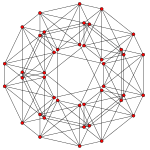 Truncated 6-simplex | |
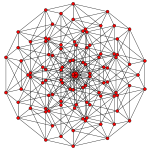 Bitruncated 6-simplex |
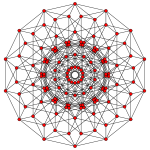 Tritruncated 6-simplex | |
| Orthogonal projections in A7 Coxeter plane | ||
|---|---|---|
In six-dimensional geometry, a truncated 6-simplex is a convex uniform 6-polytope, being a truncation of the regular 6-simplex.
There are unique 3 degrees of truncation. Vertices of the truncation 6-simplex are located as pairs on the edge of the 6-simplex. Vertices of the bitruncated 6-simplex are located on the triangular faces of the 6-simplex. Vertices of the tritruncated 6-simplex are located inside the tetrahedral cells of the 6-simplex.
Truncated 6-simplex
| Truncated 6-simplex | |
|---|---|
| Type | uniform 6-polytope |
| Class | A6 polytope |
| Schläfli symbol | t{3,3,3,3,3} |
| Coxeter-Dynkin diagram | |
| 5-faces | 14: 7 {3,3,3,3} 7 t{3,3,3,3} |
| 4-faces | 63: 42 {3,3,3} 21 t{3,3,3} |
| Cells | 140: 105 {3,3} 35 t{3,3} |
| Faces | 175: 140 {3} 35 {6} |
| Edges | 126 |
| Vertices | 42 |
| Vertex figure |  ( )v{3,3,3} |
| Coxeter group | A6, [35], order 5040 |
| Dual | ? |
| Properties | convex |
Alternate names
- Truncated heptapeton (Acronym: til) (Jonathan Bowers)[1]
Coordinates
The vertices of the truncated 6-simplex can be most simply positioned in 7-space as permutations of (0,0,0,0,0,1,2). This construction is based on facets of the truncated 7-orthoplex.
Images
| Ak Coxeter plane | A6 | A5 | A4 |
|---|---|---|---|
| Graph | 
|
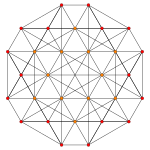
|
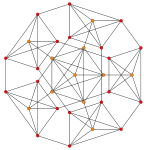
|
| Dihedral symmetry | [7] | [6] | [5] |
| Ak Coxeter plane | A3 | A2 | |
| Graph | 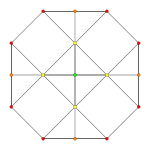
|
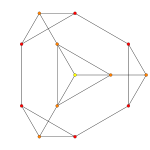
| |
| Dihedral symmetry | [4] | [3] |
Bitruncated 6-simplex
| Bitruncated 6-simplex | |
|---|---|
| Type | uniform 6-polytope |
| Class | A6 polytope |
| Schläfli symbol | 2t{3,3,3,3,3} |
| Coxeter-Dynkin diagram | |
| 5-faces | 14 |
| 4-faces | 84 |
| Cells | 245 |
| Faces | 385 |
| Edges | 315 |
| Vertices | 105 |
| Vertex figure |  { }v{3,3} |
| Coxeter group | A6, [35], order 5040 |
| Properties | convex |
Alternate names
- Bitruncated heptapeton (Acronym: batal) (Jonathan Bowers)[2]
Coordinates
The vertices of the bitruncated 6-simplex can be most simply positioned in 7-space as permutations of (0,0,0,0,1,2,2). This construction is based on facets of the bitruncated 7-orthoplex.
Images
| Ak Coxeter plane | A6 | A5 | A4 |
|---|---|---|---|
| Graph | 
|

|
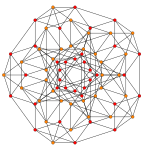
|
| Dihedral symmetry | [7] | [6] | [5] |
| Ak Coxeter plane | A3 | A2 | |
| Graph | 
|

| |
| Dihedral symmetry | [4] | [3] |
Tritruncated 6-simplex
| Tritruncated 6-simplex | |
|---|---|
| Type | uniform 6-polytope |
| Class | A6 polytope |
| Schläfli symbol | 3t{3,3,3,3,3} |
| Coxeter-Dynkin diagram | or |
| 5-faces | 14 2t{3,3,3,3} |
| 4-faces | 84 |
| Cells | 280 |
| Faces | 490 |
| Edges | 420 |
| Vertices | 140 |
| Vertex figure |  {3}v{3} |
| Coxeter group | A6, [[35]], order 10080 |
| Properties | convex, isotopic |
The tritruncated 6-simplex is an isotopic uniform polytope, with 14 identical bitruncated 5-simplex facets.
The tritruncated 6-simplex is the intersection of two 6-simplexes in dual configuration: ![]()
![]()
![]()
![]()
![]() and
and ![]()
![]()
![]()
![]()
![]() .
.
Alternate names
- Tetradecapeton (as a 14-facetted 6-polytope) (Acronym: fe) (Jonathan Bowers)[3]
Coordinates
The vertices of the tritruncated 6-simplex can be most simply positioned in 7-space as permutations of (0,0,0,1,2,2,2). This construction is based on facets of the bitruncated 7-orthoplex. Alternately it can be centered on the origin as permutations of (-1,-1,-1,0,1,1,1).
Images
| Ak Coxeter plane | A6 | A5 | A4 |
|---|---|---|---|
| Graph | 
|

|

|
| Symmetry | [[7]](*)=[14] | [6] | [[5]](*)=[10] |
| Ak Coxeter plane | A3 | A2 | |
| Graph | 
|
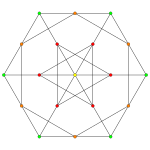
| |
| Symmetry | [4] | [[3]](*)=[6] |
- Note: (*) Symmetry doubled for Ak graphs with even k due to symmetrically-ringed Coxeter-Dynkin diagram.
Related polytopes
| Dim. | 2 | 3 | 4 | 5 | 6 | 7 | 8 |
|---|---|---|---|---|---|---|---|
| Name Coxeter |
Hexagon t{3} = {6} |
Octahedron r{3,3} = {31,1} = {3,4} |
Decachoron 2t{33} |
Dodecateron 2r{34} = {32,2} |
Tetradecapeton 3t{35} |
Hexadecaexon 3r{36} = {33,3} |
Octadecazetton 4t{37} |
| Images | 
|
 
|
 
|
 
|
 
|
 
|
 
|
| Vertex figure | ( )∨( ) |  { }×{ } |
 { }∨{ } |
 {3}×{3} |
 {3}∨{3} |
{3,3}×{3,3} |  {3,3}∨{3,3} |
| Facets | {3} |
t{3,3} |
r{3,3,3} |
2t{3,3,3,3} |
2r{3,3,3,3,3} |
3t{3,3,3,3,3,3} | |
| As intersecting dual simplexes |
 |
 |
  |
Related uniform 6-polytopes
The truncated 6-simplex is one of 35 uniform 6-polytopes based on the [3,3,3,3,3] Coxeter group, all shown here in A6 Coxeter plane orthographic projections.
Notes
References
- H.S.M. Coxeter:
- H.S.M. Coxeter, Regular Polytopes, 3rd Edition, Dover New York, 1973
- Kaleidoscopes: Selected Writings of H.S.M. Coxeter, edited by F. Arthur Sherk, Peter McMullen, Anthony C. Thompson, Asia Ivic Weiss, Wiley-Interscience Publication, 1995, ISBN 978-0-471-01003-6 [1]
- (Paper 22) H.S.M. Coxeter, Regular and Semi Regular Polytopes I, [Math. Zeit. 46 (1940) 380-407, MR 2,10]
- (Paper 23) H.S.M. Coxeter, Regular and Semi-Regular Polytopes II, [Math. Zeit. 188 (1985) 559-591]
- (Paper 24) H.S.M. Coxeter, Regular and Semi-Regular Polytopes III, [Math. Zeit. 200 (1988) 3-45]
- Norman Johnson Uniform Polytopes, Manuscript (1991)
- N.W. Johnson: The Theory of Uniform Polytopes and Honeycombs, Ph.D.
- Klitzing, Richard. "6D uniform polytopes (polypeta)". o3x3o3o3o3o - til, o3x3x3o3o3o - batal, o3o3x3x3o3o - fe





































